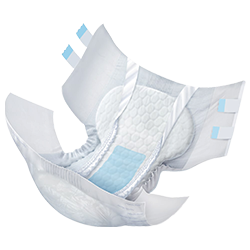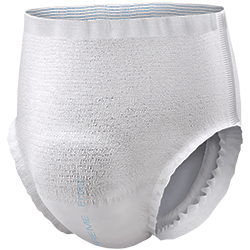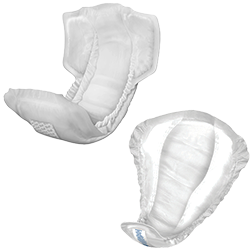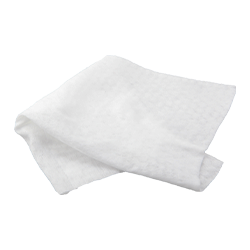What Are the Best Exercises for Incontinence?

People experiencing incontinence for the first time may worry that their lifestyles will completely change, but that doesn’t have to be the case!
With the right information — and absorbent, comfortable products that keep the wearer dry and worry-free — you can enjoy life to the fullest.
The physical and mental benefits of regular exercise are well-known. But are there specific workouts or moves that help with bladder and/or bowel control? Explore the best exercises for incontinence as well as some to avoid.

Can I Exercise with Incontinence?
Yes! Whether you want exercises to help with incontinence or just to work toward better flexibility and strength, physical activity should be a part of everyone’s life if possible. As with any fitness routine, make sure to speak with a healthcare provider first.
Note: If you’re seeking exercises specifically for older adults, check out our blog focused on fitness for seniors. You’ll learn about important questions to ask your doctor or healthcare provider, setting goals and effective routines.
Do Kegels Help with Incontinence?
If you’re experiencing a type of urinary incontinence caused by weakened pelvic floor muscles or the urethral sphincter, Kegel exercises for bladder control can help. For both men and women experiencing stress incontinence, exercises such as Kegels or squats can be easy to work into a daily routine.
Find the right muscles by stopping the flow of urine. Later, with an empty bladder, contract and hold that muscle for 3-5 seconds with a similar rest period in between.
In the beginning, work up to 10 repetitions a day and gradually increase to three sets daily. Increase the holding and releasing time up to 10 seconds as muscles get stronger.
There’s another form of Kegels that can be helpful for bowel incontinence. In addition to the repetitions above, add in contracting the anal sphincter muscles and gradually increase the sets and repetitions.
Because no one can “see” you performing these, it’s common to forget to do them on a regular basis. Set an alarm on a phone as a reminder or create an exercise journal to track performance and progress — as well as any changes in incontinence frequency or volume.
What are the Best Bladder Control Exercises?
The goal of incontinence exercises is to strengthen pelvic floor muscle support. Exercises such as crunches, sit-ups and jumping rope can place too much pressure on pelvic organs and muscles, so it’s best to avoid those when striving to manage incontinence.
When done correctly (with good form and no or low additional weight), squats can help strengthen the pelvic floor. Keep in mind to engage the core while squatting and raising, and don’t press down on the pelvic area.
Yoga and Pilates are great choices to stretch and strengthen pelvic floor muscles. They are low-impact activities that don’t require buying any special equipment. The strengthening and breathing tools used can help with managing stress incontinence in particular.
For more great moves to help manage urinary incontinence, the National Association for Continence (NAFC) recently created a Pelvic Floor Health Center and included exercise videos. Explore a range of exercises at various difficulty levels.
Can I Lift Weights with Incontinence?
Among weightlifters, urinary incontinence is a common complaint. Lifting heavy weights can put a lot of strain on the pelvic floor, particularly if the person bears down on the pelvic floor instead of engaging the core and using proper breathing techniques.
Before beginning a weightlifting routine, talk with a doctor or healthcare provider. Then, begin with lighter dumbbells and weights and focus on engaging the core instead of pressing down on the pelvic floor.
If you begin to experience stress incontinence as you lift or increase weights, pay attention to which part of the movement triggers urine leakage. You may want to decrease weight or perform that movement more slowly in order to focus on your form and make sure to breathe freely throughout the exercise.
Lifting weights can be a part of a routine that includes Kegels and other pelvic floor exercises for incontinence; however, pay attention to your body and make sure weightlifting aligns with the goals you’ve set for your health.
How Can I Prevent Leakage During Exercise?
Leading a full life that includes exercising is possible while managing incontinence. NorthShore is dedicated to helping millions of Americans with urinary or bowel incontinence live worry-free from leaks with premium high-absorbency products that offer leak-free and odor-free protection.
Get ready to enjoy exercising again by checking out our selection of protective underwear, tab-style briefs, absorbent liners, incontinence pads, accessories and other supplies. Shop online or call (800) 563-0161 for personalized assistance.
Make sure to speak with a doctor or healthcare provider before beginning a new exercise routine. This article is not a substitute for professional medical advice, diagnosis or treatment.
Thank you so much for reading our blogs!
Did you know NorthShore has helped millions of people manage incontinence with life-changing absorbent products? It's so amazing to hear their stories.
We also want you to know we have trained product advocates that provide a personal experience by working with each customer to find the best product for their situation.
Find out for yourself today!
To get in touch, simply provide your contact details below and your personal product advocate will reach out.












